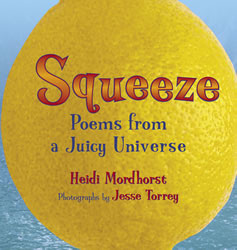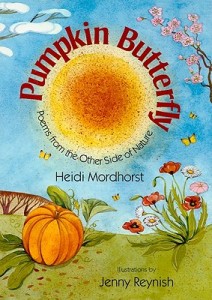Making a Meal of Poetry
by Ann Jacobus
This month, I asked poet Heidi Mordhorst to weigh in on a couple of important questions concerning kids and poetry. Heidi is a veteran teacher who has served elementary and preschool children and families in a wide range of settings and currently teaches reading to Kindergarten and 1st grade students. She is the author of two published collections of children’s poetry, Squeeze: Poems from a Juicy Universe (Wordsong/Boyds Mills Press, 2005) and Pumpkin Butterfly: Poems from the Other Side of Nature (Wordsong/Boyds Mills Press, 2009).
1. Do kids need poetry and if so, why?
In the most basic sense, poetry is what we use to teach our babies to talk. Poetry is music made of words, with or without a tune, and when we sing “Twinkle, Twinkle, Little Star” or recite “Wee Willie Winkie” to our little ones, we’re organizing language for them, tuning their ears to the sound and feel of English, helping them practice communicating through sound.
Poetry is also what we use to teach our children to read and write. When we teach them to sing the Alphabet Song, we’re organizing the elements of written English for them. When we share rhyming picture book texts, we’re developing their sense of words as discrete yet related items, categorizable by number of syllables or phoneme patterns (also known as rhythm and  rhyme).
rhyme).
From this you might guess that as a poet and teacher I favor rhymed, metered verse for children, but in fact I am a champion for the “other side.” While I see the power of verse in children’s language experience, I also see how easy it is to give our young people too much of a good thing. Think of poetry as food—I certainly do, and talk to children about how the best poems sound good to your ears and feel good in your mouth. Just as I hope we would not serve our kids chicken nuggets and sliced apples every day “because that’s what they like,” I don’t think we should be content to offer them nothing but rhymed verse, no matter how skillfully written.
A Purple Place
Purple is an inside color,
like the lining of a cape—
like the dusky
like the musky
inside of a hiding place.
.
A purple place all lined with dust
that I didn’t know was there—
a certain place
a curtain place
behind my granddad’s heavy chair.
.
And when I’m in this purple place
my heartbeat is the only sound—
among the plush
among the hush
what’s inside me rushes out.
Children also need the aspect of poetry that is carried in the content. Jack Prelutsky, a master of the rhymed verse that I’m likening to chicken nuggets (organic and locally farmed, of course!) agrees:
[Poetry is] a distillation of experience. The poetry [kids] should hear should not only be the poetry of rap music and repetitive rock lyrics….we all have these little quiet, funny parts of ourselves that want something else. I think children should have that… the other way of giving information, of learning about the larger world, of seeing.
from “Pure Poetry: A Talk with Jack Prelutsky
I believe that free-verse poetry is better able to reach into those “little quiet, funny parts” of children. It’s delicious in the way a slow-simmered seafood chowder is, or a crunchy, herby salad. These dishes are complex, like most of our life experience, and they deliver a range of flavors and textures that even the best chicken nuggets or apple slices can’t. Children may need more  time to find the music in free verse, but the rewards are great when a poem that sounds good and feels good also sinks down through your brain and lands in your heart.
time to find the music in free verse, but the rewards are great when a poem that sounds good and feels good also sinks down through your brain and lands in your heart.
Shell Game
everything about an egg
is smooth or round or cool
the shell pin-thin and brittle
the yolk a little mound of sun
the white sticky-thick and spreading
resting still as a stone in your palm
everything about an egg
is nothing like
a chick
And now look back and see how I described the difference between rhymed, metered poetry and free verse. All that food talk is metaphor, and that’s the third reason children need poetry. The kind of short-form poetry that we offer children puts metaphor at the center and exercises children’s ability to perceive analogies among unlike objects and experiences. Poetry makes us smarter, more sensitive, more flexible in our thinking.
2. How do you think poetry can best be integrated into the classroom or the library? How can parents encourage a love for poetry at home?
The answer is easy to divine but difficult to pull off: poetry can best be integrated into the classroom or the library or at home by…READING IT! Often, regularly, with relish!
There is lots to compete with poetry reading, especially in school and at home (perhaps librarians more easily avoid mathtime and bathtime), but the saving grace is that Poems Are Short. They can be squeezed in here and there all over the place, if you’re ready.
When time for reading at bedtime is short, or when your class is in line at the water fountain, read a poem. If you like it, read it again! The very best advertisement for poetry is your personal adult enthusiasm. Share poems YOU like. Talk about why you like them, briefly. If a poem leaves you cold, say so, and say why. Children will begin to answer with their agreement or arguments.
In my classroom we keep Poetry Friday, along with much of the blogosphere. My students add each featured poem to their personal anthologies and respond in drawing and writing. I select poems that relate to whatever else is going on in the classroom, and we don’t overthink—we read and reread, notice one feature of the poem, and enjoy. The aim for these young students is poetry experience. With plenty of this under their belts, they can come to later poetry study ready to weigh in with a positive attitude.
“A Purple Place” is from Squeeze, “Shell Game” is from Pumpkin Butterfly.










